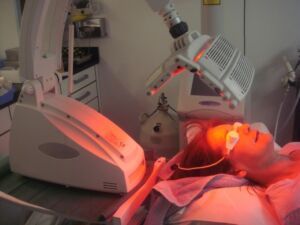Photodynamic therapy treats premalignant growths by using special drugs called photosensitizing agents, along with light, to kill pre-cancerous cells. The drugs only work after being activated by certain wavelengths of light. The process also is known as PDT, photoradiation therapy, phototherapy and photochemotherapy.
What you should know about photodynamic therapy for premalignant growths
The procedure requires three steps: application, incubation and light activation. First the drug is applied to the skin in the treatment area, usually in the form of a liquid or cream.
The drug is allowed to air dry and then incubated anywhere from 30 to 60 minutes up to 18 hours, depending on the condition and treatment site.
The skin is exposed to a special blue light source. The patient may feel a slight tingling or warmth. Sometimes a fan is used to cool the treatment area. Following treatment, the treated area is cleansed and a sunscreen applied.
The interaction between the photosensitizing agent and light treatment activates an oxygen molecule that can destroy nearby cells. Once the treatment area has healed, it is re-examined to see if any additional treatments are necessary.
.
Why choose photodynamic therapy for premalignant growths
Photodynamic therapy can be used to treat premalignant conditions such as actinic keratoses. Other benefits of the procedure include:
- Â Â Â No long-term side effects.
- Â Â Â Minimally invasive.
- Â Â Â Can be administered in a doctor’s office.
- Â Â Â Can be administered multiple times to the same treatment area.
- Â Â Â Little or no scarring.
- Â Â Â Improved skin appearance, tone, color and texture.

